¶ 1 Leave a comment on paragraph 1 0 BY CORY TAMLER
¶ 2 Leave a comment on paragraph 2 1 The former home of the late Dr. Josephine English is in Weeksville. Now subsumed within the larger Brooklyn neighborhood of Crown Heights, it was one of the oldest free black communities in the United States. Dr. English was the first African-American woman to have an OB/GYN practice in the state of New York; as an historical figure, she is both connected to mainstream Western medicine and to a long lineage of black female caregivers and healthcare practitioners whose skills, knowledge, and actions have had to circulate out of the public eye. An example of the latter is the United Order of Tents, a secret society of black nurses founded in 1867, whose legacy artist Simone Leigh uncovered while conducting research for her Free People’s Medical Clinic: “The most startling discovery was the work of the Tents. One wonders why their legacy isn’t common knowledge…Much of black culture is developed, honed and supported within these groups. It seems that having a real humanity in the public sphere is often impossible, and so often black culture is cultivated in private.”[1] Unfurling from this statement, I want to look at two intertwined, multidisciplinary artworks staged by Leigh between 2014 and 2016 as responses (not answers) to the question with which Michael Warner opens his Publics and Counterpublics (2002): “What kind of world would make the values of both publicness and privacy equally accessible to all?”[2] Leigh’s Free People’s Medical Clinic (hereafter the FPMC, 2014) and The Waiting Room (2016) mediate a Warnerian counterpublic and complicate, through their staging of the private in public, the private-public binary. In so doing, they become a model for counterpublics to intervene in the public sphere without dissolving into it.
¶ 3 Leave a comment on paragraph 3 0 The Free People’s Medical Clinic at Stuyvesant Mansion, Brooklyn (2014)
¶ 4 Leave a comment on paragraph 4 0 Occupying Dr. English’s remodeled former home at 375 Stuyvesant, the Free People’s Medical Clinic was Leigh’s response to a Creative Time[3] commission inviting the artist to imagine a project for Weeksville. Two years of research led to a month in 2014 during which a full, rich array of bodies and actions inhabited the house, which functioned as community center, health clinic, and performance space—often, all three at once.
¶ 5 Leave a comment on paragraph 5 1 Fusing elements of performance, installation, duration, and community partnerships, the FPMC can be seen as a formal departure from Leigh’s previous, primarily sculptural work. It can also be seen as an extension of her central concerns and techniques. Her sculpture consists of “works that investigate the power of handmade objects to pass along knowledge and index black women’s bodies”[4]; it layers materials heavy with the weight of historical and symbolic significance, like cowrie shells, with contemporary body shapes and objects. The FPMC, too, enacts a complex transhistorical layering that aims to make space for the bodies and actions of black women in our understanding of public health across time, both as recipients and givers of care. The interdisciplinary form it takes to do so is social practice[5], an approach which takes as its material the institutional and social structures within which the artist works.
¶ 6
Leave a comment on paragraph 6 0
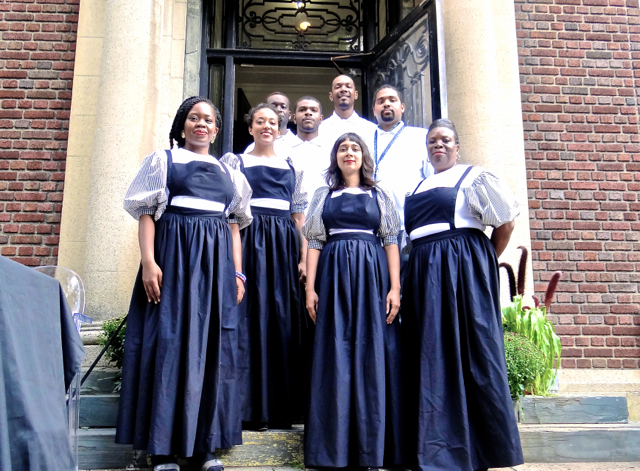 Simone Leigh’s The Free People’s Medical Clinic, 2014. See image at source (The Brooklyn Reader).
Simone Leigh’s The Free People’s Medical Clinic, 2014. See image at source (The Brooklyn Reader).
¶ 7 Leave a comment on paragraph 7 1 Location and visual elements (attendants, for example, were all dressed in nineteenth-century nurses’ garb) brought Dr. English and the Tents into the work, while the title evokes the Black Panther Party; Leigh calls the FPMC a “recreation” of the clinics by the same name run by the Party in the 1960s and 70s.[6] But it was doing something more complicated than reenactment. Samara Davis notes the DJ playing in the entranceway to the brownstone gave it an “occult vibe” through which it “eerily held two time periods in tension: the house’s dark wood and early 20th-century details giving way to the next century’s purple light and electronic pulse.”[7] This transhistorical tension animated the entire work, from its embodied elements to its spatiality. Anachronistic costumes and a preparatory etiquette class meant to help them approximate “Southern gentility”[8] contextualized the contemporary bodies of the attendants; so did the laptops they used to check visitors in. Weeksville’s significance as one of the first free black communities was juxtaposed with the tangible presence of the still mostly African-American neighborhood’s very current lack of access to public services. For visitors to the FPMC outside of the community, one way this made itself felt was on the walk from the train. Both St. Mary’s Hospital, which served a largely uninsured population of patients who often could not pay their bills and was bankrupted and shuttered in 2005, and Interfaith Medical Center, which has the longest emergency room wait times in the state of New York and is now the community’s primary source of emergency care[9], are within blocks of 375 Stuyvesant. To walk past what one visitor and critic calls “a massive, derelict building, a shell of a building, empty, boarded up, covered in graffiti”[10] on your way to visit an artwork about hidden black lineages of care is to be violently confronted with the continued lack of access to public health in the community and the continued urgency for care to continue, visible or invisible, by whatever means necessary.
¶ 8
Leave a comment on paragraph 8 0
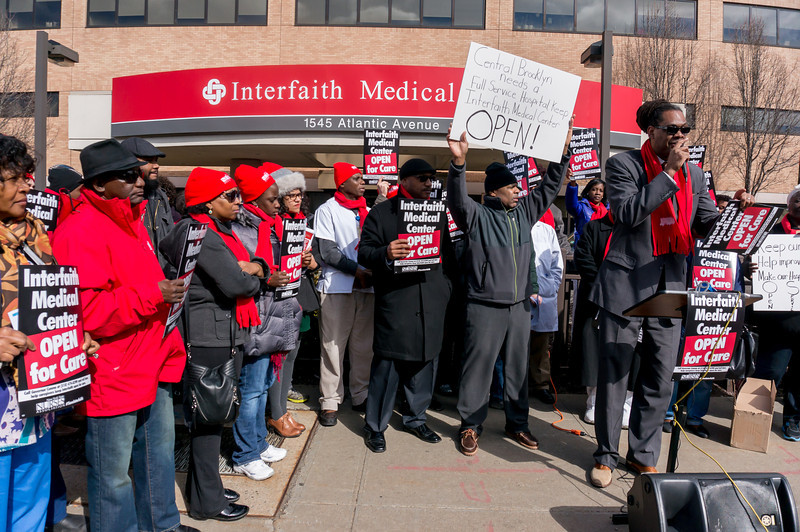 Protesters at Interfaith Medical Center in 2015. See image at source (The Brooklyn Reader).
Protesters at Interfaith Medical Center in 2015. See image at source (The Brooklyn Reader).
¶ 9 Leave a comment on paragraph 9 0
¶ 10 Leave a comment on paragraph 10 0 The Waiting Room, The New Museum for Contemporary Art, Manhattan (2016)
¶ 11 Leave a comment on paragraph 11 0 For several months in the summer of 2016, Leigh’s project The Waiting Room took over the New Museum’s Fifth Floor, and occasionally the entire museum. Visitors to the Fifth Floor walked out of the elevator and into a white room lined with sandbags, its floor patterned with square pillows, a projection of the head of a black woman rotating inside of a massive clay vessel against one wall. Around the corner, a small hallway contained video documentation of the FPMC and several other videos referencing the Tents, the Black Panther Party, and some examples from recent history of the ways that the African-American body has been represented and policed in public health narratives. The third publicly-accessible space was the Apothecary, lined with large glass jars full of herbs. On the wall, a chalkboard tracked the day’s schedule of activities and events. Afrocentering happening now. Tomorrow: massage 1–4pm. Sign up tomorrow. Traditional museum-style explanatory wall text, however, was at a minimum. Visitors could engage with all of this simply as an installation; a little curiosity or experimentation was necessary to open up the relational dimension of the work. For example, visitors could sit on the pillows in the main gallery space and meditate—or talk, or read the exhibition broadsheet, or look at their phones. If they spoke to the teenaged attendant in the Apothecary, she or he would help them identify the herbs and offer them samples to smell, and answer questions about the exhibition. Nowhere did wall text explain that the sandbags were references to the Black Panther Party, but the attendants held this knowledge.
¶ 12
Leave a comment on paragraph 12 0
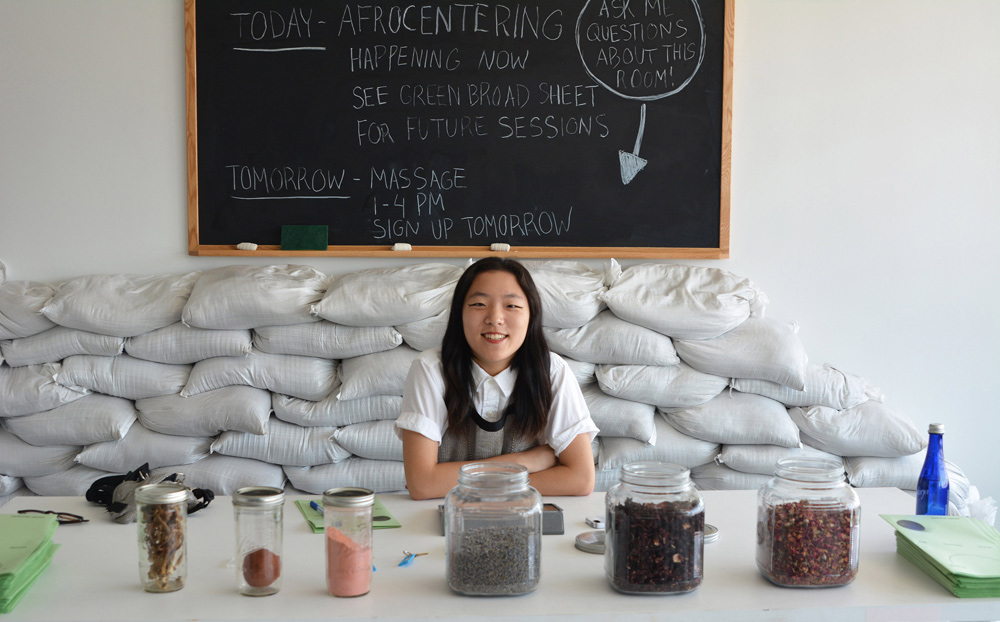 A teen attendant in the Apothecary as part of Simone Leigh’s The Waiting Room, 2016. See image at source (BOMB Magazine).
A teen attendant in the Apothecary as part of Simone Leigh’s The Waiting Room, 2016. See image at source (BOMB Magazine).
¶ 13 Leave a comment on paragraph 13 1 The Waiting Room was an evolution and outgrowth of the FPMC, and retained many of the latter’s key features and collaborators through its series of care sessions open to the public that included community acupuncture, massage therapy, Afrocentering, and herbalism workshops. As framed by the curatorial team and Leigh, The Waiting Room featured “a new installation and a private, ‘underground’ series of classes for community partners,” as well as workshops and healing treatments grouped under the title “care sessions.”[11] Its core focus was on alternative strategies and histories of care based particularly on the knowing and actions of black women; this focus would allow artist and institution to “consider the possibilities of disobedience, desire, and self-determination as they manifest in resistance to an imposed state of deferral and debasement”[12]. Though its expressed aims are similar and core subject matter nearly identical to the FPMC, the move from 375 Stuyvesant to the New Museum dramatically reshaped the project. It shed its original name taken directly from the BPP clinics and took on a new title referencing the story of Esmin Elizabeth Green, who died after waiting for twenty-four hours in the psychiatric emergency room of Kings County Hospital in Brooklyn without being seen in 2008. It left a brownstone haunted by its former resident whose life was bound up in the work Leigh is referencing and excavating to enter the white cube of a contemporary art museum. It traveled from the physical context of Weeksville to the nexus of Soho and the Lower East Side where it was situated in close proximity to art galleries, high-end clothing stores, and a Whole Foods, but also to The Bowery Mission shelter and cheap Chinatown restaurants. Attendants were now drawn from participants in the New Museum Teen Apprentice Program supervised and supported by museum curatorial and education staff, eliding the direct embodied reference to the Tents represented by the FPMC attendants. With the FPMC, the artist started from the prompt to “use what was already here in the community” as the core of her proposal, a boundary she took “really seriously: to use this community as the material of the project without bringing anything from the outside in.”[13] Visitors to The Waiting Room entered something that was, much like the FPMC, part installation art, part community space, part performance, part history exhibit; unlike the FPMC, though, the community cannot be considered the project’s material. Instead, the material was the institution itself. Just as the properties of clay and marble impose different restrictions and techniques on a work of sculpture and make very different objects possible, the contextual and institutional material of a work of social practice influence and restrict the project in ways that become part of its aesthetics. Instead of simplistically working against the institution of the museum, Leigh worked with and within it in ways that dynamically exposed, overran, and expanded its boundaries.
¶ 14 Leave a comment on paragraph 14 0
¶ 15 Leave a comment on paragraph 15 0 Public Performances of the Private
¶ 16 Leave a comment on paragraph 16 1 Leigh’s stance towards the importance of the private, through its repetition and reiteration over the course of multiple interviews, artist statements, and curatorial framings, comes to form a central concern of the project. Reiterating an earlier formulation in discussing the FPMC: “It seems that having a real humanity in the public sphere is often impossible, and so often black culture is cultivated in private.”[14] Or in the context of The Waiting Room, more pithily, and more personally: “If you can’t be a human being in public, you take it to a private place.”[15] I want to suggest and highlight some ways that Leigh’s two closely-related performative installations (differently) perform being human in private in public. Allowing the shape of the private to take up space in the public without having to expose the entirety of the private’s interior opens an approach for us to break down the private-public binary, suggesting that the performance of privacy in public can maintain the essentially local elements of the private while giving it the means to affect, agitate in, and shift the public sphere.
¶ 17 Leave a comment on paragraph 17 2 An art project open to the public, funded by an organization with visibility as high as Creative Time, and written up in popular media outlets can reference, but cannot recreate, the urgency of the care the Tents provided. Similarly, a well-known contemporary art museum can title a portion of its programming “underground” (see below), but its very inclusion within the institutional structure means it is far from what a resistance movement or counterpublic might mean by that term. In reenacting for a contemporary public elements of black culture and strategies of various counterpublics cultivated in private, Leigh worked to correct their invisibility to the public eye—a invisibility that has been, however, crucial for their existence. In no way does Leigh’s work advocate for the abolition of the private. In fact, both the FPMC and The Waiting Room explicitly make room for private or semi-private spaces that have a degree of public legibility. These become proposals for the coexistence of public and private that provide alternatives to consensus-based social models. How might we make room for difference in ways that do not require it to be fully known and therefore solved/resolved/dissolved?
¶ 18 Leave a comment on paragraph 18 0 In many ways, this private-in-public-space-making was quite literal. 375 Stuyvesant, once a private home, became a public artwork for a month. Things that took place within the closed clinic rooms of the FPMC, like acupuncture, dance, or yoga, would also happen in its waiting room, because Leigh “wanted to display what was going on inside the rooms, so the clinic is revealing itself in and through these performances as a space of collective healing.”[16] The degree of privacy of physical spaces was also part of The Waiting Room. Massage therapy and community acupuncture sessions took place in an entirely private room not visible or accessible to anyone who was not a participant in one of these sessions. But the boundary between spaces could be quite porous. During Afrocentering workshops, which took place in the main gallery space usually occupied by the cushions and meditative video described above, a curtain would be drawn across the gallery to create a semi-private space for workshop participants. Punched all over with holes, the curtain allowed visitors entering the gallery to peek at—not watch—the bodies moving behind it.
¶ 19
Leave a comment on paragraph 19 0
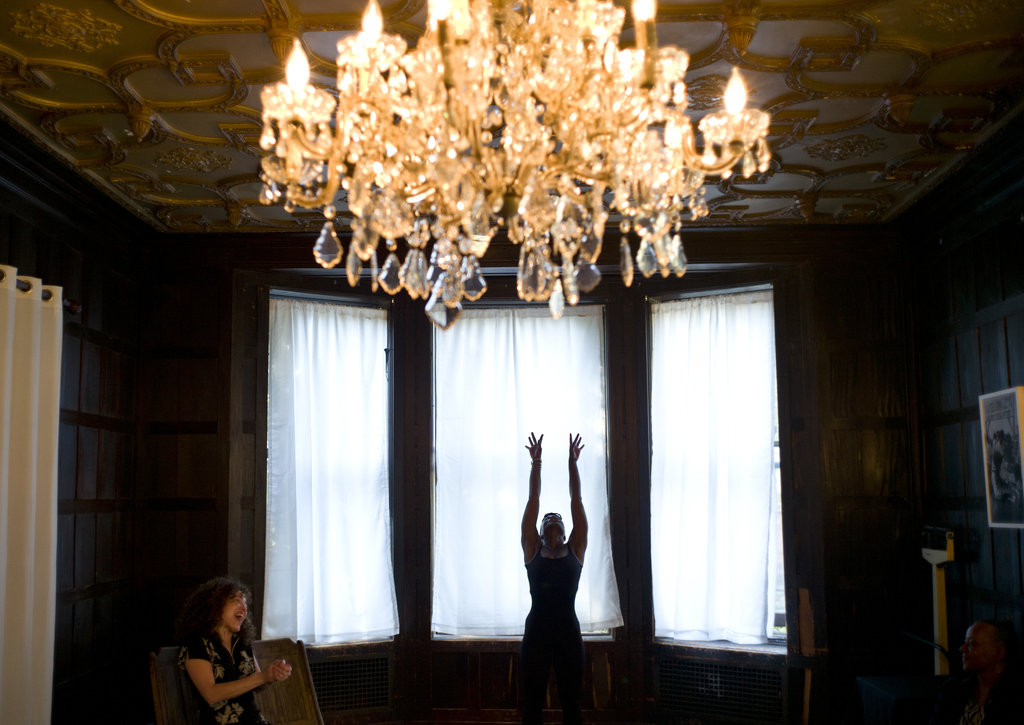 Performances by Kendra Foster (left) and Aimee Meredith Cox in the waiting room of Leigh’s The Free People’s Medical Clinic. See image at source (The New York Times).
Performances by Kendra Foster (left) and Aimee Meredith Cox in the waiting room of Leigh’s The Free People’s Medical Clinic. See image at source (The New York Times).
¶ 20 Leave a comment on paragraph 20 0 Though audience response is notoriously difficult to analyze, it is important to talk about Leigh’s complex constitution of her work’s audience through her construction of varying degrees of access. The exhibition was open to anyone visiting the museum; care sessions were open, on a first-come, first-served basis, to anyone who signed up. This general, self-selecting public was far from being the work’s only audience, or its most important. Leigh and her collaborators arranged special care sessions open only to museum staff, aimed in particular at security and customer service positions—an act that called internal attention to the class- and race-based divide between custodial and curatorial employees. Then there were private invited workshops: a series of courses “geared toward creating an arsenal of skills to sharpen the critical thinking, self-awareness, and strategic planning of young black women in New York,”[17] and taiko drumming workshops with young adults from the Hetrick-Martin Institute. Publicly branded “The Waiting Room Underground,” these workshops were otherwise sealed off from the general public; this publicizing of the private both reaffirmed the need for such safe spaces and named the existence of the groups they served. A similar dynamic was at play during the FPMC, which limited some classes and events to (for example) queer-only, trans-only, or South Asian-only participants.
¶ 21 Leave a comment on paragraph 21 0 Another major category of audience-participant particular to The Waiting Room was #BWAforBLM (Black Women Artists for Black Lives Matter), a collective of one hundred black women artists invited by Leigh to meet on a weekly basis during her New Museum residency. The collective organized a highly visible public event in September 2016, claiming the entire museum (a kind of staged takeover, in collaboration with the institution itself) for performances, screenings, ritual, and music. Though the visibility of this making-space-through-taking-space was certainly important to the members of the collective—who all wore striking, symbolic red for the duration of the event and not only occupied the entire museum, but processed through the surrounding streets to the museum as an opening ritual—many of them echo the idea that they were their own most important audience[18]. This points to the importance of ritual and process in the event, but also defines the event as a point in a process that cannot be fully understood by a public that experiences just the event; as collective member Kameelah Janan Rasheed says, “Everyone who attended the event was able to see the final product, but what people were unable to witness with the energy and spirit of our planning, where we grappled with what it means to collaborate ethically and sustainably, how this intervention functions in the larger ecology of arts-based responses, as well as how to hold space and nurture one another.”[19]
¶ 22
Leave a comment on paragraph 22 0
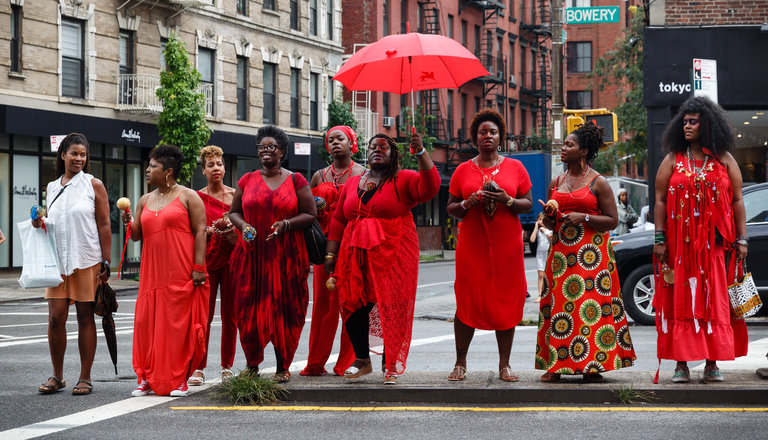 A contingent of the collective #BWAforBLM in the streets near the New Museum, 2016. See image at source (The New York Times).
A contingent of the collective #BWAforBLM in the streets near the New Museum, 2016. See image at source (The New York Times).
¶ 23 Leave a comment on paragraph 23 0 These multiple audience layers and multiple possible modes of engagement were a key element of both projects. The FPMC and The Waiting Room each formed not one public, but many—and made these publics and counterpublics visible to one another. Making private spaces and private conversations publicly visible but not infiltratable was a way of surrendering claims to artistic objectivism and detachment, opting instead for a relational aesthetic that located the art at the moment of human engagement. It also proposed a model of unity quite different from the rhetoric of sameness and colorblindness that ultimately allows systemic racism to mutate into ever-more-slippery forms[20]. Leigh’s is a unity that does not deny that the way bodies look forces them to move differently through the world; it invites everyone to consider the same difficult social realities, and affirms that our approach and needs will be shaped by our identities.
¶ 24 Leave a comment on paragraph 24 1 What can art do in the political realm, in the public sphere? In the FPMC and The Waiting Room, Simone Leigh consistently pushed back against the “it’s not enough” mentality, reaffirming that these were artistic gestures; that she is an artist and not foremost an activist; that there are things it’s not necessary to expect of art, even of art that’s social practice. Michael Warner cautions that “when alternative publics are cast as social movements—they acquire agency in relation to the state. They enter the temporality of politics and adapt themselves to the performatives of rational-critical discourse. For many counterpublics, to do so is to cede the original hope of transforming, not just policy, but the space of public life itself.”[21] To make one concrete and directly relevant comparison: Black Lives Matter, founded by Patrisse Cullors, Opal Tometi, and Alicia Garza to respond specifically to the acquittal of Trayvon Martin’s killer and more broadly to the impact state violence has on black lives, entered the temporality of politics when it moved from its origins as a social media hashtag to a social movement centering the work of black women, queer, trans, and disabled folk within the black liberation movement. As the website says: “This is Not a Moment, but a Movement”[22]. While I am not suggesting that Black Lives Matter’s formalization as a social movement represents ceding transformative hope, the shaping effect of rational-critical political discourse is evident in the ways the movement works to make itself politically and socially legible. It must develop platforms and demands; it must build for longevity and impact; it must counter its own impulse toward decentralized and polyvocal leadership in order to fit a political paradigm that demands leaders.
¶ 25 Leave a comment on paragraph 25 1 Like Black Lives Matter, Leigh’s work discussed here “broaden[s] the conversation to include black life”[23] and denies simplistic conceptualizations of unity that ignore difference. But art, even when it seems to be doing some of the work of politics, organizing, or social services in the world, need not be subject to a political temporality. Visitors and participants in the FPMC expressed interest in the project’s longevity, but Leigh was ambivalent.[24] “If I can do some good work,” she says in an interview, “I don’t think I should not make it because I cannot prove that it will last forever.”[25] Leigh is straddling the realm of art and the realm of healthcare, affirming the importance of this straddling as an irreducible part of both the artistic and political work. Leigh and her collaborators and audience-participants will remain an alternative (artistic) public. She does not need to explain what is meant by her transhistorical layering in the FPMC, or write a series of concrete demands for healthcare based on The Waiting Room’s care sessions, or explain why she holds visible private space for black women to learn and organize. She can allow the meanings and interpretations to be irreducibly multiple. This is what makes the work rich, relational, and transformative. This is what makes it not a social movement, but art.
¶ 26 Leave a comment on paragraph 26 0 Footnotes
¶ 27 Leave a comment on paragraph 27 0 [1] Rizvana Bradley, “Going Underground: An Interview with Simone Leigh,” Art in America (August 20, 2015), http://www.artinamericamagazine.com/news-features/interviews/going-underground-an-interview-with-simone-leigh/.
¶ 28 Leave a comment on paragraph 28 0 [2] Michael Warner, Publics and Counterpublics (New York: Zone Books, 2002): 21.
¶ 29 Leave a comment on paragraph 29 0 [3] A commissioning and presenting organization that, over the past four decades, has worked “with thousands of artists throughout New York City, across the country, around the world—and now even in outer space. Our work is guided by three core values: art matters, artists’ voices are important in shaping society, and public spaces are places for creative and free expression…We are committed to presenting important art for our times and engaging broad audiences that transcend geographic, racial, and socioeconomic barriers” (http://creativetime.org/about/). The web archive of the FPMC on the Creative Time site is available here: http://creativetime.org/projects/black-radical-brooklyn/artists/simone-leigh/.
¶ 30 Leave a comment on paragraph 30 0 [4] Jared Quinton, “Simone Leigh’s Free Clinic Channels the Anonymous Labor of Black Women,” Artsy (July 12, 2016), https://www.artsy.net/article/artsy-editorial-simone-leigh-s-new-show-offers-up-survival-tactics-for-black-women.
¶ 31 Leave a comment on paragraph 31 0 [5] See Shannon Jackson, Social Works: Performing Art, Supporting Publics (New York: Routledge, 2011). Jackson argues that to take social practice seriously might be to view its negotiation of an external governance as part of the artwork itself (29).
¶ 32 Leave a comment on paragraph 32 0 [6] Bradley, “Going Underground.”
¶ 33 Leave a comment on paragraph 33 0 [7] Samara Davis, “Room for Care: Simone Leigh’s Free People’s Medical Clinic,” TDR: The Drama Review Vol. 59 No. 4 (Winter 2015): 169.
¶ 34 Leave a comment on paragraph 34 0 [8] Davis, “Room for Care,” 170.
¶ 35 Leave a comment on paragraph 35 1 [9] A site-specific performance of Edward Albee’s The Death of Bessie Smith at Interfaith Medical Center in January 2014, produced by New Brooklyn Theater, became a highly visible part of the efforts to keep the hospital open and was another example of complex performative layering of histories that exposed the way the racism of contemporary urban space blocks access to healthcare, often fatally, in a process that looks very much like segregation-era inequality of access.
¶ 36 Leave a comment on paragraph 36 0 [10] Joe Osmundsen, “How Many Black Histories We Still Don’t Know: An Interview With Simone Leigh,” The Feminist Wire (October 3, 2014), accessed May 9, 2017, http://thefeministwire.com/2014/10/many-black-histories-still-dont-know-interview-simone-leigh/.
¶ 37 Leave a comment on paragraph 37 0 [11] “New Museum – Simone Leigh: The Waiting Room,” e-flux (June 11, 2016), accessed May 9, 2017, http://www.e-flux.com/announcements/49780/simone-leigh-the-waiting-room/.
¶ 38 Leave a comment on paragraph 38 0 [12] Ibid.
¶ 39 Leave a comment on paragraph 39 0 [13] Osmundsen, “How Many Black Histories We Still Don’t Know.”
¶ 40 Leave a comment on paragraph 40 0 [14] Bradley, “Going Underground.”
¶ 41 Leave a comment on paragraph 41 0 [15] Qtd. in Jenna Wortham, “Black Health Matters,” The New York Times (August 27, 2016), https://www.nytimes.com/2016/08/28/fashion/black-lives-matter-wellness-health-self-care.html.
¶ 42 Leave a comment on paragraph 42 0 [16] Bradley, “Going Underground.”
¶ 43 Leave a comment on paragraph 43 0 [17] “New Museum – Simone Leigh: The Waiting Room,” e-flux.
¶ 44 Leave a comment on paragraph 44 0 [18] Jillian Steinhauer, “Reflections from Black Women Artists for Black Lives Matter,” Hyperallergic (September 15, 2016), accessed May 9, 2017, https://hyperallergic.com/322742/reflections-from-black-women-artists-for-black-lives-matter/.
¶ 45 Leave a comment on paragraph 45 0 [19] Ibid.
¶ 46 Leave a comment on paragraph 46 0 [20] See Michelle Alexander, The New Jim Crow: Mass Incarceration in the Age of Colorblindness (New York: The New Press, 2012): 13–14 (and elsewhere).
¶ 47 Leave a comment on paragraph 47 0 [21] Warner, Publics and Counterpublics, 89.
¶ 48 Leave a comment on paragraph 48 0 [22] Black Lives Matter, “About,” accessed May 9, 2017, http://blacklivesmatter.com/about/.
¶ 49 Leave a comment on paragraph 49 0 [23] Black Lives Matter, “Herstory,” accessed May 9, 2017, http://blacklivesmatter.com/herstory/.
¶ 50 Leave a comment on paragraph 50 0 [24] Davis, “Room for Care,” 174.
¶ 51 Leave a comment on paragraph 51 0 [25] Osmundsen, “How Many Black Histories We Still Don’t Know.”

In her analysis of a failed Cuban slave revolt, Ada Ferrer discusses knowledge not accessible to white authority figures. A leader of this revolt is questioned. Ferrer writes, “… unscripted gestures of defiance that suggested to the interrogators that they, black men, were privy to a knowledge that they would not share or clarify beyond a certain point. Nerey’s ignorance would stand, Aponte seemed to say. He understood how history rendered these images coherent, even if Nerey could not.” The meaning here that is not explicated or made obvious, the meaning that has to be made through interaction, the layers of understanding as a speaking back to a colonial effort to expose and classify… (See page 303 of Ferrer, Ada. Freedom’s Mirror: Cuba and Haiti in the Age of Revolution. New York: Cambridge University Press, 2014.)